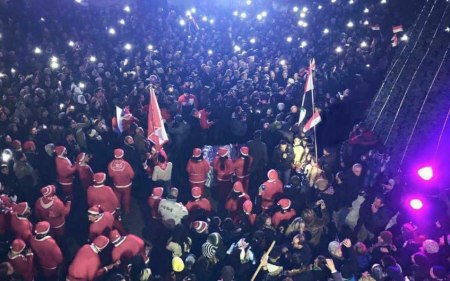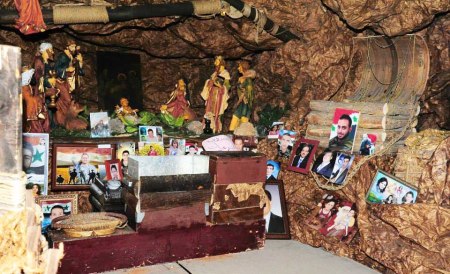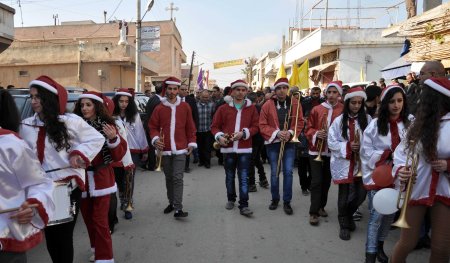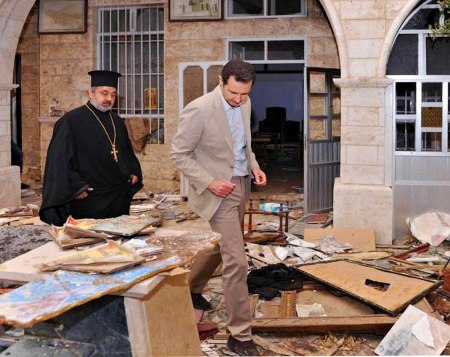The situation in Syria’s Aleppo dominated media news reports for several month and people may wonder why Aleppo suddenly dropped from the news roster. Shouldn’t there, as Assad’s thugs unfortunately have crushed the heroically resisting defenders of Aleppo, not enough stories emerge about terror, bloodlust, and monstrous crimes? Wouldn’t it be the duty of news media to expose the savagery and pure evil of the Assad regime, as Assad’s thugs have free hand to rape, torture, and slaughter the now unprotected women, children, and elderly, left behind in the ruins of Aleppo?
Not only do mass media outlets fail to feed the horror of an Assad-controlled Aleppo to their audiences, Christian (!!!) news agencies publish despicable articles who try to whitewash the Assad regime and who are suggesting, that food, shelter, medical car is provided, public services are restored, and people are not fleeing, but even returning and celebrating the victory of Assad’s butchers.
A few examples:
The Christian publication Herald Malaysia writes:
These extremist groups who have tried to drag the people into obscurantism, attempted to target the celebrating crowds with a terrorist attack which was foiled by the police. A bomb ready to explode was placed on Aziziya square, to sow fear and uncertainty but also to curb the massive return of all internally displaced persons, who had left the city soon after the rise of the rebels and jihadists.
About one million people originally from Aleppo returned to the city after the liberation by the government forces, all ready to pick up their lives from where they were suddenly interrupted by jihadist groups. They want to rebuild, re-open businesses and factories, return the equipment stolen by militias and smuggled into Turkey. In the area there is an atmosphere of enthusiasm and dynamism, elements that have always characterized the people of Aleppo.
The news of the bomb and the explosion failed to shake the people, now immune to the “tricks” of the fighters “for freedom” and supporters of a “caliphate wanted by foreign forces”. Citizens ironically see what is happening in the exact opposite of what had happened earlier. Everything began with bombs and terrorists attacks, followed by the occupation of the districts east of Aleppo and the arrival of the jihadists. Now what happens is exactly the reverse: the jihadists are fleeing, preceded by the liberation of the neighborhoods in the east and they return to basics with the bombs and terrorist attacks. Although it may seem paradoxical, the population considers the attempted attack a good sign; it is a sign of the utter despair and bewilderment of jihadist groups, now powerless and forced to cowardly and unpredictable attacks.
The Catholic communication agency DICI writes:
Emile Katti, surgeon and director of al-Raja hospital in Aleppo, told Vatican news agency Fides that the sister of one of the hospital’s employees, together with her whole family, was killed by hidden gunmen as they tried to leave eastern Aleppo through the humanitarian corridor. Sharing his own experience, he added, “The sick and wounded coming from these parts of the city speak of hunger and of having to eat grass, the food, of which there was enough, was only for the militia and their supporters.” The tales of persons coming from zones controlled by jihadi militias bring details often not known by the media… In the liberated zones, the houses of worship have been found profaned and graves destroyed and vandalized, according to Catholic press agency Asianews, in Rome.
Fr. Ziad Hilal, a Jesuit, has been working since September in Aleppo for the Jesuit Refugee Service (JRS) and for Aid to the Church in Need (ACN), after six years in the city of Homs, Syria. On December 14, for the first time in five years, he was able to travel to zones of eastern Aleppo liberated from rebel control by government forces. On his return, he was questioned by Andrea Krogmann, and replied, “I have been able to take a look at the situation, especially in the Christian zone of Al-Midan. The sight before you is one of total destruction. Our center, Saint Vartan, is also very damaged.” As for the so-called massacres of civilians by the Syrian army and its allies in the course of the liberation of eastern Aleppo, as described by international media, he said he is “doubtful about these stories.” “There are perhaps isolated cases, but we have not heard of them here,” explained Fr. Ziad. “You must know that nowadays there is much false information circulating and also false photos. The organizations on the ground such as the Red Cross have not spread this kind of news up to now.” He added, “It must be said that the media have played a deplorable role in this war.”
Thanks to humanitarian corridors, “many persons have left the eastern part of the city to come to the west. Numerous organizations are there to help them. It was very cold today [December 14].” The Jesuit added that if “the battle of Aleppo was fierce,” and a large part of the city totally destroyed, “we must maintain hope, or else why are we still here?” He concluded, “Aleppo has had many conquerors in the course of its history. Thousands of persons have died here and it was destroyed several times. And yet it has always risen again. Let us therefore be hopeful!”
“Christmas lights have returned to western Aleppo for the first time,” Bishop Antoine Audo SJ, Chaldean bishop of Aleppo, to the Roman telejournal of Catholic station TV2000 on December 19. “It has been six years since in the Christian quarters of western Aleppo, Christmas was celebrated with decorations and lights.” “Today,” Bishop Audo said, “you cannot hear any shots; there is a total change. People are happy. I saw — for the first time in a long time — Christmas trees on balconies. On the square of the Christian quarter, a Christmas tree has been set up as well and decorated.”
AsiaNews.it writes:
According to well-informed sources contacted by AsiaNews, the people of Aleppo have celebrated with singing and dancing on the rubble strewn streets; in general there is an atmosphere of widespread joy, in spite of the ravages of war and the conflict signs that are visible everywhere.
However, the biggest victory for Aleppo is not the liberation of the city from jihadists and insurgents, which in four years failed to foster the support of the population, rather the total failure of their attempt to kill the spirit of tolerance and coexistence between religions and ethnicities. This is peculiar to Syria and especially its northern metropolis, and Jihadist extremism could not erase it.
In fact, in a sign of triumph Aziziya – the Armenian Christian Quarter of Aleppo — erected a giant Christmas tree, festively illuminating the streets. Moreover, yesterday evening a band, composed of Armenian youth dressed as Santa Claus, performed in the square to the delight of the entire population of the area.
The lighting of the tree was witnessed by Muslims and Christians alike, all united in joy and celebrating the holiday season in a typical climate, that has nothing to do with the Islamic holidays.
===============
The irony is hopefully not lost on the readers of this blog post, and there is nothing more to do than to round up the text by some background facts about Christianity in Syria:
Syria’s Christian community, existing for two millennia, was 2.2 million strong before the war and has dwindled in only six years to about 600,000. This is ethnic cleansing, in some instances even genocide, though no one in the West will ever address this issue.
Christians always played an important role in Syria’s history. Michel Aflaq, co-founder of the Baath Party, which has ruled Syria since 1963, was a Christian, and Christians rose to senior positions in the party, government and security forces. Dawoud Rajiha, Syria’s Defense Minister who was assassinated by Islamists in 2012, was a Christian.
In January 1973, Hafez al-Assad, Bashar’s father, implemented a new constitution which led to a national crisis. Unlike previous constitutions, this one did not require that the president of Syria must be a Muslim, leading to fierce demonstrations in Hama, Homs and Aleppo organized by the Muslim Brotherhood and the ulama. They labeled Assad as the “enemy of Allah” and called for a jihad against his rule. Assad’s coming to power was an unprecedented development and shocking to the Sunni religious elite which had monopolized power for many centuries.”
As Hafez al-Assad had to appease the Muslim fanatics, the Constitution of Syria now states that the President has to be a Muslim. However, Syria does not profess a state religion, and Muslim leaders frequently criticized this and called for change.
The largest Christian denominations in Syria are the Greek Orthodox Church of Antioch, the Melkite Catholic Church, the Syriac Orthodox Church, and the Armenian Apostolic Church. There is also the Assyrian Church of the East and the Chaldean Catholic Church. All denominations have accepted Russia’s position, originally dating from the 19th century, as a protector of Christianity in the region. “Russia has given hope to the people of Syria,” according to Patriarch Ignatios Ephrem II, leader of the Syrian Orthodox church.
This is surely an additional strong motive for Russia’s involvement in Syria.
Aleppo, before the war with 200,000 members the largest Christian community, now houses only 30,000. The city was also the location of historical important Christian churches, going back to the faith’s earliest years. Today any still-functioning Christian churches in the city are only in the western, government-controlled districts, Churches in the eastern districts are vandalized, destroyed, and mostly damaged beyond repair.
Christians in the eastern districts have left long time ago. The fear for their lives and the lives of their children forced families to take the tough decision to flee to Lebanon or beyond. The few who didn’t leave were killed, and this happened not only in Aleppo but in the whole of Syria.
A few examples:
In April 2013, Bishop Boulos Yazigi and archbishop Yohanna Ibrahim were abducted by gunmen north of Aleppo. Nothing has been heard about them since and it is assumed, that they have been murdered. Two other priests, Michael Kayyal and Maher Mahfouz, kidnapped in February 2013, are known to have been executed. In June 2013, 49-year-old Fr François Murad was killed by a gunshot inside his church in the Christian village of al-Ghassanieh. In October 2012, Fr Fadi Haddad, a Greek Orthodox parish priest in Qatana, south-west of Damascus, was kidnapped. His badly disfigured body was discovered later on the roadside. Fr Frans van der Lugt, a Dutch Jesuit who lived in Syria for 40 years, was shot dead in Homs on April 7, 2014. Fr Paolo Dall’Oglio, a charismatic Italian Jesuit, was kidnapped in July 2013 by IS and most likely killed. Fr Jacques Mourad was kidnapped in May 2015, nothing has been heard of him since.
13 nuns, kidnapped by jihadists in Maalula, were luckier and freed after Qatar paid 16 million US$ ransom.
In areas seized by IS (Islamic State), Jabhat Fateh al-Sham, and other Islamic groups, Christians have been ordered to convert to Islam, pay jizya (a religious tax), or face death. In the Syrian province of Hassakeh in February 2015, hundreds of Christians have been kidnapped by Islamists who demanded exorbitant high sums of ransom.
Christians in Syria are persecuted and killed by Islamic militants, including the Western sponsored “moderate rebels.” There is no way to deny this and one has to ask, why Western powers support this war against Syrian Christianity?
One cannot blame people if they start believing in conspiracy theories about Barack Hussein Obama’s faith, John Brennan’s Muslim conversion, Clinton aid Huma Abedin’s Muslim Brotherhood links, and Saudi influence in general.
But, conspiracy theories aside, there is one simple explanation for the neglect of the Christian persecution by Western powers: Christians are simply in the way of a Pax Americana in the Middle East, which can only be achieved with the collusion of Israel, Saudi Arabia plus the other Gulf monarchies, and Turkey.
If there would be an oil-rich Christian nation in the Middle East, things would look different.
Related posts:





Keine Kommentare:
Kommentar veröffentlichen